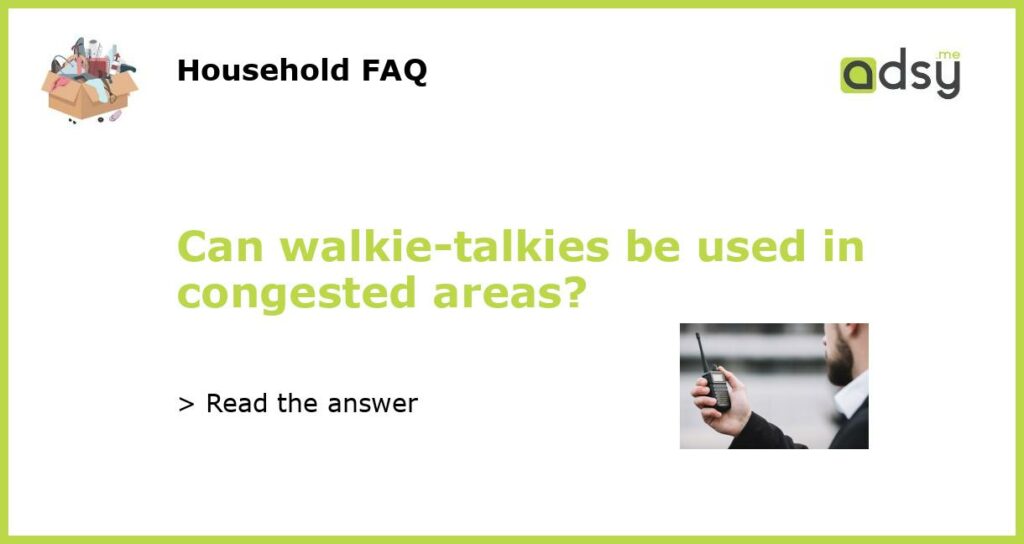Walkie-Talkies in Congested Areas: A Practical Solution
Walkie-talkies have long been a reliable means of communication, especially in settings where cellular networks are limited or unavailable. However, can they be used effectively in congested areas? This article explores the feasibility and practicality of using walkie-talkies in such environments.
The Challenges of Congested Areas
Congested areas pose unique challenges for communication devices like walkie-talkies. The high concentration of people and structures can lead to signal interference and limited range. Additionally, the noise levels in crowded places can make clear communication difficult.
When using walkie-talkies in congested areas, the following factors should be considered:
- Interference from other devices and frequency congestion
- Limited range due to obstacles and signal obstruction
- Noise levels affecting clarity of communication
- Potential security risks if the channel is not properly protected
- Compliance with local regulations and licensing requirements
Overcoming Interference and Frequency Congestion
Interference from other devices and frequency congestion is a common issue in congested areas. This can result in static, garbled messages, or complete signal loss. To overcome this challenge, using walkie-talkies with advanced frequency-hopping spread spectrum (FHSS) technology can be highly effective.
FHSS technology allows the walkie-talkie to detect and switch between multiple frequencies within a certain range. This minimizes the chances of interference by constantly hopping between different channels. It ensures clearer and more reliable communication, even in congested areas.
Overcoming Limited Range and Obstacles
The limited range of walkie-talkies is a well-known limitation, especially in congested areas with numerous obstacles that impede the signal. Tall buildings, dense foliage, and other structures can obstruct the radio waves, significantly reducing the effective range of the devices.
To overcome this challenge, using a walkie-talkie with higher power output or employing a repeater system can extend the range. A repeater is a stationary device that receives and retransmits the signals, allowing communication over longer distances. It can be placed at a high elevation or strategic location to bypass obstacles and provide clearer communication.
Noise Reduction for Clearer Communication
In congested areas, noise can interfere with the clarity of walkie-talkie communication. Background noise from crowds, vehicles, or machinery can make it difficult to hear and understand messages. This can result in miscommunication or missed instructions, potentially leading to safety issues.
To address this challenge, modern walkie-talkies often come equipped with noise-cancelling features such as voice activation (VOX) and digital noise reduction. VOX allows hands-free communication by automatically activating the microphone when the user starts speaking. Digital noise reduction filters out background noise, enhancing the clarity of the transmitted audio.
Ensuring Security and Compliance
Security is a critical consideration when using walkie-talkies in congested areas. Open or unsecured channels can be intercepted by unauthorized individuals, compromising sensitive information or creating safety risks.
One way to address this concern is by using walkie-talkies with built-in encryption capabilities. Encryption ensures that the transmitted messages are securely coded and can only be decoded by authorized users. It protects the integrity and confidentiality of the communication, reducing the risk of unauthorized access.
Moreover, it is important to comply with local regulations and licensing requirements when using walkie-talkies in congested areas. Each country or region may have specific rules and frequency allocations for radio communication devices. Adhering to these guidelines ensures smooth operation and prevents legal issues.
While walkie-talkies face challenges in congested areas, they can still be used effectively with the right equipment and strategies. Advanced technologies such as FHSS, repeater systems, noise reduction features, and encryption help overcome the limitations and deliver clear, secure communication in crowded environments. By considering these factors and complying with local regulations, walkie-talkies can be a practical solution for communication in congested areas.






